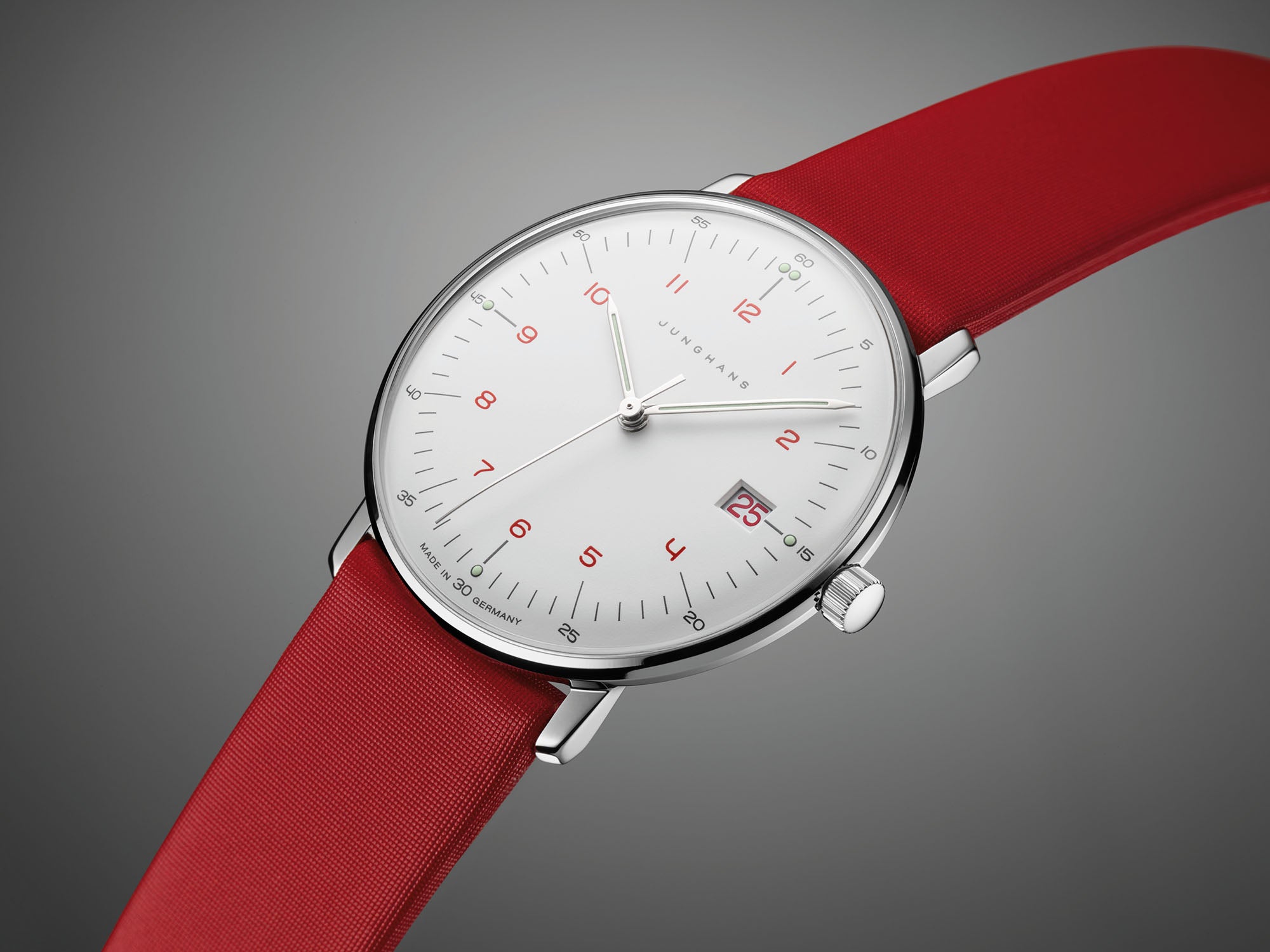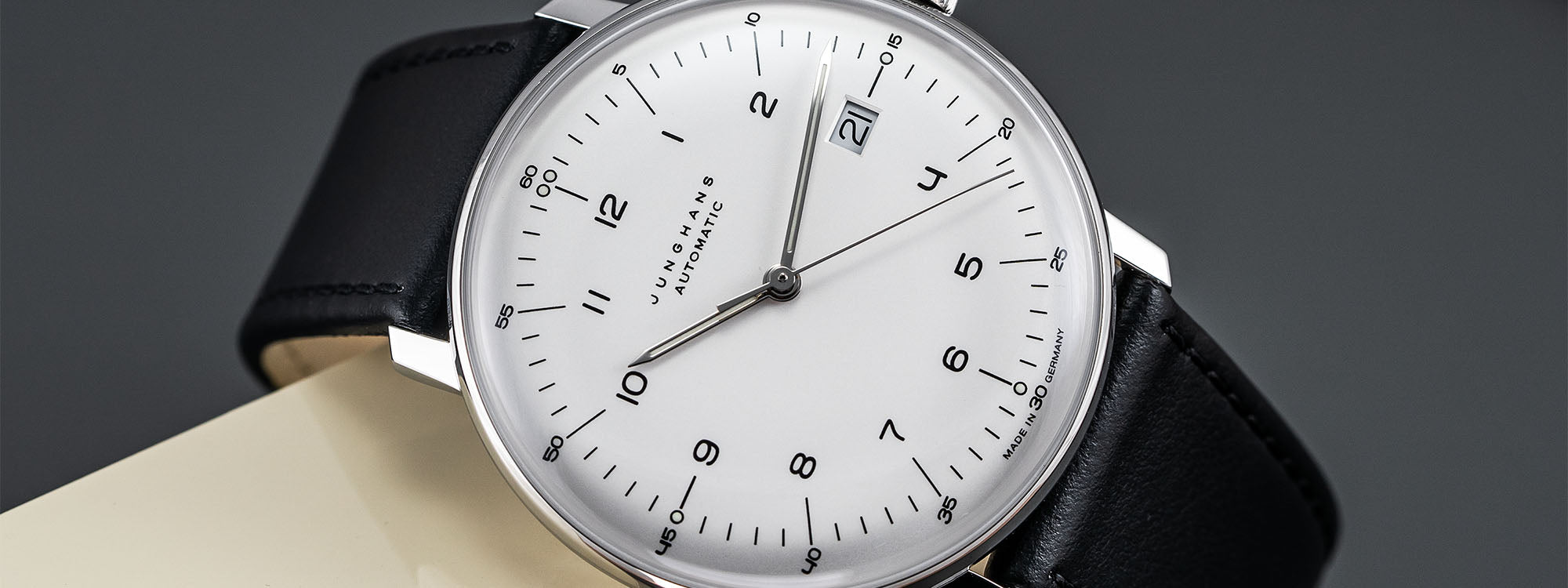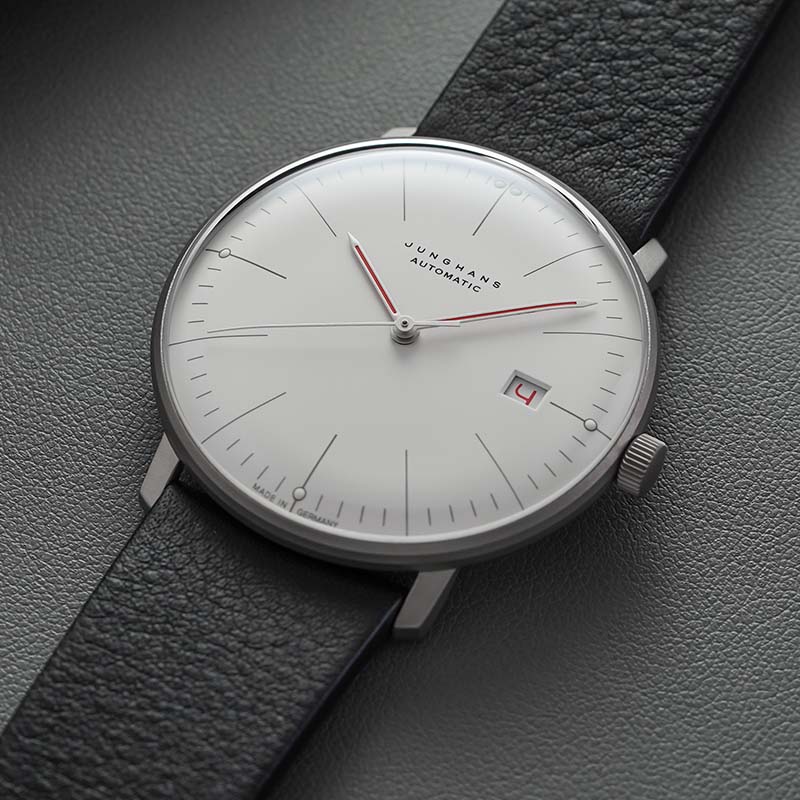Watches with a sparse, minimalist aesthetic have a faithful following in the modern era, and a number of watchmakers, both Swiss and German, offer timepieces born of those design principles, which are most directly descended from Germany’s hugely influential Bauhaus school of design in the early 20th Century. The Junghans Max Bill series, however, is one of the undisputed trailblazers of the Bauhaus style of watch design, tracing its origins all the way back to 1861 and boasting a time-tested design from one of the movement’s leading legends, Max Bill himself. Here we offer a brief history of the Junghans Max Bill watch collection, some insight into its namesake, and an overview of the modern collection, one of the few to contain mechanical, automatic, quartz, and radio-controlled solar movements as well as an array of sizes and materials.
HOROLOGY IN THE BLACK FOREST
 Junghans Uhren GmbH was founded in 1861 in Schramberg, in Germany’s eastern Black Forest, by Erhard Junghans and his brother-in-law Jakob Zeller-Tobler. Initially a producer of clock parts, the company began making its own complete clocks and pocket watches in 1866 and by 1903 had become the largest watch and clock manufacturer in the world, employing 3,000 people. In 1927, Junghans began making wristwatches as well as clocks and supplied both over the subsequent decades to clients in the German military as well as the commercial market. A watershed moment for the company arrived in the 1950s with the release of the Kitchen Clock with Timer, a teardrop-shaped wall clock that incorporated a kitchen timer, designed by Max Bill, a Swiss architect, painter, and graphic designer who studied at Germany’s Bauhaus and is credited with exerting the most decisive and pervasive influence on Swiss graphic design in the modern era. Bill applied his distinctive, minimalist aesthetic to the series of wristwatches that would bear his name in 1961 and the collection has grown and thrived ever since.
Junghans Uhren GmbH was founded in 1861 in Schramberg, in Germany’s eastern Black Forest, by Erhard Junghans and his brother-in-law Jakob Zeller-Tobler. Initially a producer of clock parts, the company began making its own complete clocks and pocket watches in 1866 and by 1903 had become the largest watch and clock manufacturer in the world, employing 3,000 people. In 1927, Junghans began making wristwatches as well as clocks and supplied both over the subsequent decades to clients in the German military as well as the commercial market. A watershed moment for the company arrived in the 1950s with the release of the Kitchen Clock with Timer, a teardrop-shaped wall clock that incorporated a kitchen timer, designed by Max Bill, a Swiss architect, painter, and graphic designer who studied at Germany’s Bauhaus and is credited with exerting the most decisive and pervasive influence on Swiss graphic design in the modern era. Bill applied his distinctive, minimalist aesthetic to the series of wristwatches that would bear his name in 1961 and the collection has grown and thrived ever since.
WHO WAS MAX BILL?

Born in Winterthur, Switzerland, Max Bill (1908-1994, above) began his artistic studies at the famous Bauhaus campus in Dessau, Germany in 1927 after a three-year apprenticeship to a silversmith. After studying under illustrious teachers including Wassily Kandisnksy, Paul Klee, and Oskar Schlemmer, Bill moved to Zurich to begin his career in architecture and graphic design. In 1937, he became the driving force behind Allianz, a group of Swiss artists who adopted Bill’s “Concrete Art” approach of emphasizing geometric abstraction and colors, and his work as an industrial designer, strongly influenced by Bauhaus principles of design clarity and precise proportions, impacted Swiss graphic design for decades to come. One of Bill’s most noteworthy product designs is found in 1954’s Ulmer Hocker, a sleek, versatile wooden furniture piece that could simultaneously serve as a step stool, side table, a shelving addition, or miniature desk. He also created paintings and multimedia sculptures, both with geometrical themes, and designed notable buildings in Berlin, Zurich, and Florence, as well as a large granite sculpture on Zurich’s Bahnhofstrasse (below), one of the world’s most exclusive and expensive shopping districts.

In a long career as an educator, writer and lecturer, Bill founded the Ulm School of Design in Germany, which taught design principles in the Bauhaus tradition, and even became active in politics, serving as a member of the Swiss National Council from 1967 to 1971. Along with the “Ulm Stool,” one of Max Bill’s other most noteworthy product designs was the one that he contributed to the watch manufacturer from the Black Forest, and the fruitful multi-year partnership that would produce a line of wristwatches that would stand the test of time well into the 21st Century.
FROM WALL CLOCKS TO WATCHES

In keeping with its designer’s Bauhaus sensibilities, the concept behind the original Max Bill Küchenuhr (“kitchen clock,” above), produced commercially by Junghans in 1956, was simple and eminently utilitarian: combine the kitchen wall clock, often the only stationary timekeeper in a household, with the kitchen timer used in the preparation of meals, in a single streamlined package. The iconic, light-blue-colored, reverse-teardrop-shaped timepiece currently resides in New York’s Museum of Modern Art as an icon of product design; in 2021, Junghans released a modern version that faithfully channels the look and spirit of the original mid-century classic. Beginning in 1861, Bill, whose grandfather was a watchmaker, started designing wristwatches for Junghans as well as clocks. The first Max Bill watches were dainty by modern standards, just 34mm in diameter, and sported a white dial with three stick hands and thin, oversized hour indexes with luminous dots at 3, 6, and 9 o’clock, and a double dot for orientation at 12 o’clock. In keeping with the Bauhaus spirit of simplicity, the first model had neither numerals nor a date window. Junghans followed up that model with another numerical-dial version whose Arabic hour numerals were in an elegant, rounded font designed by Bill himself. As tastes, trends, and technology in the watch industry evolved over the ensuing decades, the Max Bill watch would evolve along with them, while never abandoning its stylistic roots.
THE COLLECTION
Max Bill Automatic

At the forefront of the contemporary Max Bill family is the three-handed Automatic, which comes in a 38mm case and contains the self-winding, Swiss ETA-based Junghans Caliber J800-1 with a 38-hour power reserve. Most of the cases are in stainless steel, some with a black or gold PVD coating, and the high-contrast dials, mostly in white or black, offer either numerical or all-index designs as well as options with or without a date display. The watches are mounted on calf leather straps or steel Milanese-style bracelets.
Price: $1,045 - $1,450, Case Size: 38mm, Case Thickness: 10mm, Crystal: Sapphire, Water Resistance: 30 meters, Movement: Automatic Caliber J800-1 (ETA 2824-2 base)
Max Bill Automatic Bauhaus

Deserving of its own shout-out among the Automatic options is the Bauhaus edition, released in 2019 in commemoration of the 100th anniversary of the founding of the Bauhaus. The anthracite PVD coating on the steel case of the 1,000-piece limited edition evokes the facade of the Dessau building while the red hands and red date window pay tribute to its famed red doors. The gray strap, Junghans says, is inspired by the concrete used in the construction of the building, which is also represented in an illustration on the sapphire caseback.
Price: $1,400, Case Size: 38mm, Case Thickness: 9.7mm, Crystal: Sapphire, Water Resistance: 50 meters, Movement: Automatic Caliber J800-1 (ETA 2824-2 base)
Max Bill Kleine Automatic

“Kleine” means “small” in German, and the Kleine Automatics offer the wearer a timepiece at the exact same retro dimensions as the original Max Bill models from 1861. Curiously, however, the Kleine Automatic departs from the 1861 model in several respects: several models have numerals in the Max Bill font and all have a date window at 3 o’clock. The watches feature the same movement as the larger Automatics and a similarly diverse, albeit not as vast, variety of case options, bracelets, and colorways.
Price: $1,070, Case Size: 34mm, Case Thickness: 10mm, Crystal: Sapphire, Water Resistance: 30 meters, Movement: Automatic Caliber J800-1 (ETA 2824-2 base)
Max Bill Handwound
For those traditionalists still enamored with the ritual of winding their watch daily, Junghans offers the Handaufzug (Handwound) editions of the Max Bill, outfitted with the ETA-based Caliber J805.1, whose power reserve is slightly more robust than that of the Automatic models, at 42 hours. The Handaufzug models are also available in both numerical and all-index dials — all sans date display — covered by a domed crystal made of convex hardened plexiglas with scratch-resistant coating, which can be retrofitted on request with a sturdier sapphire glass.
Price: $800 - $1,400, Case Size: 34mm, Case Thickness: 9mm, Lug Width: 18mm, Lug to Lug: 37mm, Crystal: Plexiglas (sapphire optional), Water Resistance: 30 meters, Movement: Hand-wound Caliber J805.1 (ETA 2801-2 base)
Max Bill Chronoscope
The Chronoscope sports objectively the most contemporary aesthetic among the Max Bill models — those in the know often point out that it was designed after Bill’s death in 1994 — but still clearly on-theme with the collection’s overall mission statement. The dials in matte silvery-white, matte black, or anthracite gray opt for either indices or numerals at the hour markers and feature a bicompax layout of vertical subdial counters at 12 o’clock and 6 o’clock, eschewing an additional small seconds subdial but adding a date window at 3 o’clock. The integrated chronograph movement is based on the tried-and-tested ETA Valjoux 7750, with a 48-hour power reserve. At a case diameter of 40mm (in steel or PVD-coated steel), the Chronoscope is the largest member of the Max Bill family though still understated in its overall impression. The trio of “Datum Englisch” editions display the day and date in dual windows at 3 o’clock rather than just the date.
Price: $2,100 - $2,300, Case Size: 40mm, Case Thickness: 14.4mm, Crystal: Plexiglas (sapphire optional), Water Resistance: 30 meters, Movement: Automatic Caliber J880.2 (ETA 7750 base)
Max Bill Mega Solar

If the Chronoscope represents the Max Bill collection’s most contemporary design, the Mega Solar models — all descendants of the original MEGA-1 in 1990, the first radio-controlled solar watch — embody its most avant-garde foray into materials and technology. The 38mm cases are made of tough-but-lightweight titanium and inside them is a radio-controlled, electronic movement that is powered by solar energy: one full charge of sunlight, through the solar cell in the domed dial, should be sufficient to charge the watch for nearly three years. On its exterior, the Mega Solar is just as stylishly sparse as the the three-hand models with hand-winding and automatic movements, despite its array of technical functionalities, including radio-controlled time calibration and a perpetual calendar that requires no date correction until the year 2400. Also speaking to the enviro-friendly theme of the solar-powered watch, the straps are made of vegetable-tanned leather.
Price: $1,050 - $1,100, Case Size: 38mm, Case Thickness: 9mm, Lug Width: 20mm, Lug to Lug: 42.5mm, Crystal: Plexiglas (sapphire optional), Water Resistance: 30 meters, Movement: Radio-controlled Solar Caliber J101.65
Max Bill Quartz

Like many existing watch models whose launch predates the 1970s Quartz Revolution (or Quartz Crisis, depending on whom in the watch industry you ask), the Max Bill at one point became available in a budget-friendly version with a quartz caliber (the Germans spell it “quarz” without the “t”). With a similar range of dial and case options, and sized at the same 38mm, the Max Bill Quarz models are largely indistinguishable from the Automatics, except for their superior precision and noticeably more accessible price points.
Price: $600 - $700, Case Size: 38mm, Case Thickness: 7.9mm, Lug to Lug: 40mm, Crystal: Plexiglas with hard coating, Water Resistance: 50 meters, Movement: Quartz Caliber J645.33 (ETA 955.112 base)
Max Bill Ladies
 Also powered by Swiss-made, ETA-based quartz movements are the Max Bill Damen (“Ladies”) models, sized at a traditionally feminine 32.7mm. One of the most extensive collections within the Max Bill portfolio, the Damen watches currently comprise 20 references with a wide variety of colorful straps as well as steel-mesh Milanese bracelets; the straps are fitted with quick-release mechanisms for easy changing and accessorizing of straps with outfits. Among the choices is a textile strap made from recycled PET bottles.
Also powered by Swiss-made, ETA-based quartz movements are the Max Bill Damen (“Ladies”) models, sized at a traditionally feminine 32.7mm. One of the most extensive collections within the Max Bill portfolio, the Damen watches currently comprise 20 references with a wide variety of colorful straps as well as steel-mesh Milanese bracelets; the straps are fitted with quick-release mechanisms for easy changing and accessorizing of straps with outfits. Among the choices is a textile strap made from recycled PET bottles.
Price: $600 - $1,195, Case Size: 32.7mm, Case Thickness: 6.9mm, Crystal: Sapphire, Water Resistance: 50 meters, Movement: Quartz Caliber J643.29 (ETA 955.412 base)
You can shop our selection of Junghans watches here.























































3 Comments
Great article, but note that the Max Bill wristwatch was introduced in 1961, not 1861 (which was 4 years before Junghans was founded and 47 years before Max Bill was born!).
Now that I have 3 Junghans watches, two of them plexiglass and one of them sapphire, I can confirm that while the strength of sapphire is nice, the plexiglass is definitely the more appealing because of the way it renders light, distortion and magnification. The plexiglass is also stronger than people seem to think. I wouldn’t hesitate to get the original plexiglass version, and one can always swap the crystal out for sapphire down the road if desired. The only thing I’ve noticed between the two is my Valjoux 7750 spins a lot less in the sapphire version, so maybe the sapphire crystal makes the case just a tiny bit tighter?
I’m just curious. What was the last Junghans watch that Max Bill designed before he passed away?